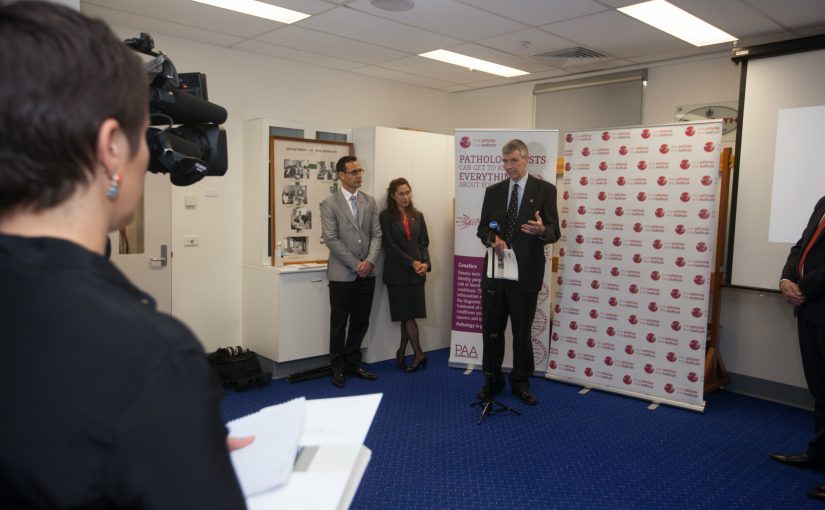Download the full Value of Pathology report or an infographic including key pathology facts.
Pathology testing saves lives and money according to a new report released today. Half the Australian population had a pathology test in the last 12 months. According to the report a third of the rise in tests requests is from doctors as they seek to prevent or minimise the impact of disease.
Pathology testing is central to controlling important, growing chronic diseases including diabetes. Managing diabetes without pathology has been compared to trying to drive a car without a steering wheel.
One in two GP visits involves a request for pathology tests. 60% of GP referrals for pathology relate to preventative health strategies and management of chronic illness. The report notes that 32% of the increase in clinical demand for pathology is due to preventative health treatments.
The Economic Value of Pathology is a meta-analysis conducted by the Centre for International Economics that examines three key health areas: diabetes, heart attack and colorectal cancer. Pathology is practiced in laboratories and is a largely unseen area of healthcare. The report was commissioned by Pathology Awareness Australia to quantify the value of investment in pathology.
70% of medical decisions rely on information from pathology testing and all cancer diagnosis is made by pathology investigations.
Pathology includes tests on blood, urine, swabs and biopsies, and provides detailed information to doctors. The report says Australia has among the highest quality pathology in the world and results produced by a workforce of 35,000 underpin the standards of overall healthcare.
Enhanced diagnostic technologies combined with the ageing population and an increasing focus on prevention, has spurred growth. Men over 75 in particular now access more testing for chronic disease management and preventative health strategies.
The total cost of delivering 500 million pathology tests per year across the community and in hospitals is estimated at 3 per cent of total health spending.
Report author Sarina Lacey from the Centre for International Economics says the findings highlight the need to invest appropriately in pathology:
“Pathology offers tremendous return on investment. With so many people with and projected to develop diabetes and other chronic conditions, it’s important to make smart, cost-effective decisions before health problems become expensive to manage. Getting health expenditure in the right areas makes good economic sense and pathology can make this happen.”
Pathology testing a defence against ballooning diabetes treatment costs
Diabetes related testing accounts for 10.5% of the growth in requesting from general practice and 6% of all GP orders for pathology.
1.7 million Australians have diabetes and this is forecast to rise to 3.5 million within 17 years. Diabetes complications account for 14% of preventable hospitalisations, 67% of Australian adults with diabetes have high blood pressure, and 68% die of heart disease or stroke.
Pathology tests are integral to diabetes prevention programs. The report notes that Type 2 diabetes prevention programs can save between $2,600 and $5,300 per life year.
The Haemoglobin A1c (HbA1c) blood test indicates the level of long-term blood sugar control. Proactive action on regular HbA1c results can help keep levels normal in people with diabetes. A small sustained decrease can reduce the cumulative incidence over five years in: end stage kidney disease by 40%; amputation by 21%; advanced eye disease by 43%; and heart attack by 16%.
Pathology Awareness Australia Ambassador A/Prof Graham Jones is a Pathologist at Sydney’s St Vincent’s Hospital. He specialises in testing for diabetes and says,
“Pathology underpins most of healthcare – you can’t do without it. Diabetes is defined by pathology tests – we have no other tools to see if we’re winning against the condition. Trying to manage diabetes without pathology is like trying to drive a car without a steering wheel!”
Sturt Eastwood, CEO of Diabetes NSW says,
“Diabetes is a significant, expensive problem that continues to grow at an alarming rate. Helping people prevent diabetes or reduce their complications is a win for the individuals involved and for the economy as a whole. Pathology testing is a vital part of diabetes management.”
$167 million per year can be managed down by ruling out heart attacks in Emergency Departments
Patients with chest pain account for approximately 10% of Emergency Department (ED) presentations. Approximately 1 in 5 cases will be for heart attack with the remainder for more benign conditions. At current ED attendance rates, $167 million per year is required to triage chest pain patients prior to hospital admission or direct discharge.
The Troponin blood test is an essential tool to diagnose and rule out heart attack. Recent advances in Troponin tests have allowed costs to be partially managed down. Newer Troponin tests may allow 40% of chest pain patients to be discharged earlier if used to their full potential.
Smart testing matches patients with the best therapies
Personalised medicine has revolutionised cancer care, and is only possible because of pathology. Pathology can now test the genetic characteristics of cancer to determine if a treatment will work on a patient.
Smart tests can match the patient with the appropriate drug therapy. The report notes that the KRAS and RAS mutation gene tests have been found to provide net cost savings to the Australian Government by ruling out treatment for patients that won’t respond well, and reducing harm and improving outcomes for patients that will.
This has underpinned dramatic improvements in survival and reductions in deaths from colorectal cancer over the past decade, with the 5–year survival rate for metastatic colorectal cancer having risen dramatically up to 67 per cent.
Download the full Value of Pathology report or an infographic including key pathology facts.

